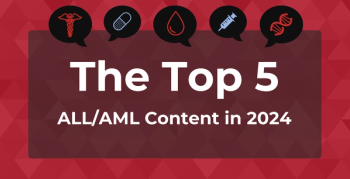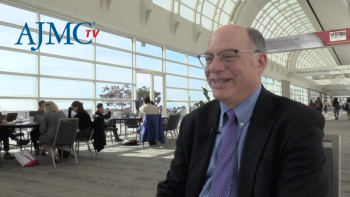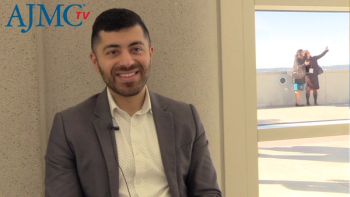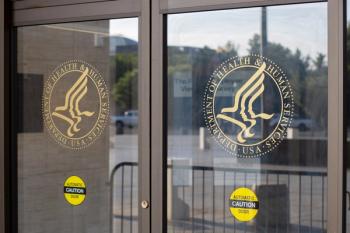
Laura Joszt, MA

Laura is the vice president of content for The American Journal of Managed Care® (AJMC®) and all its brands, including Population Health, Equity & Outcomes; Evidence-Based Oncology™; and The Center for Biosimilars®. She has been working on AJMC since 2014 and has been with AJMC’s parent company, MJH Life Sciences®, since 2011.
She has an MA in business and economic reporting from New York University. You can connect with Laura on LinkedIn or Twitter.
Articles by Laura Joszt, MA






The most-read obesity articles of 2024 mostly focused on insurance coverage of weight loss medications and costs.

Demonstrating improvements in patient quality of life using patient-reported outcomes are important for treatments for myeloproliferative neoplasms (MPNs), said Jennifer Vaughn, MD, of The Ohio State University Comprehensive Cancer Center.

Experts discussed the great advances and innovations they’ve seen this year in acute myeloid leukemia (AML) and multiple myeloma.

New treatments and adverse events impacting patient quality of life were among the topics of interest in 2024.

Bispecific antibodies show strong initial uptake in community settings for multiple myeloma treatment, particularly among Black patients compared with clinical trials.

By reducing cytokine release syndrome and neurotoxicity, prophylactic tocilizumab could facilitate safe outpatient administration of bispecifics to treat multiple myeloma (MM), explained Robert Rifkin, MD.

A shorter duration of venetoclax treatment for newly diagnosed acute myeloid leukemia (AML) may enhance efficacy and reduce toxicity, according to Amir Ali, PharmD, BCOP.

The SEQUOIA study's 5-year follow-up confirms zanubrutinib's safety profile and low cardiovascular events in treatment-naive chronic lymphocytic leukemia, according to Mazyar Shadman, MD, MPH, of Fred Hutchinson Cancer Center.

The accelerated approval was based on the results of the eNRGy trial of 64 patients with NRG1-positive non–small cell lung cancer and 30 patients with NRG1-positive pancreatic adenocarcinoma.

Gene therapies can be life-changing for people, but the high cost plus the burden of treatment remain barriers to access and utilization, explained Kevin Niehoff, PharmD, BCMAS, of IPD Analytics.

The US can learn from what other countries are doing well to implement the best programs to improve patient access to care, especially for those who have the worst outcomes, explained Nadine J. Barrett, PhD, MA, MS, FACCC, of Wake Forest University and the Association of Cancer Care Centers.

November is Diabetic Eye Disease Awareness Month. Diabetes is the leading cause of preventable blindness in the US. Here is a look at recent research related to diabetic eye diseases.

Palliative care is quality care, and providers and health systems need to do a better job at ensuring there is equity in palliative care, said Nadine J. Barrett, PhD, MA, MS, FACCC, of Wake Forest University and the Association of Cancer Care Centers.

Tyler Sandahl, PharmD, of Mayo Clinic, and Michael Byrne, DO, of Tennessee Oncology, discuss practical advice for bringing bispecifics to the community.

Patients with locally advanced hepatocellular carcinoma (HCC) who achieve a complete response after locoregional therapy and immunotherapy may be able to follow a watch-and-wait protocol.

Patients experienced similar safety and efficacy if they received first-line or later-line treatment for unresectable hepatocellular carcinoma (u-HCC).

Lindsay Bealor Greenleaf, JD, MBA, discusses how the appointment of Robert F. Kennedy Jr as HHS secretary could affect health care services in the future.

In the hours after President-elect Donald J. Trump tapped Robert F. Kennedy Jr to lead HHS, reactions came swiftly to the controversial pick who would have a large influence to shake up public health.

A new risk score model for hepatocellular carcinoma using standard clinical data can better identify individuals at risk better than the current standard risk models.

Over time, biosimilars are gaining traction in the US and becoming preferred products, explained James D. Chambers, PhD, of Tufts Medical Center.

The chimeric antigen receptor T-cell therapy obecabtagene autoleucel received approval to treat patients with relapsed or refractory (R/R) B-cell acute lymphoblastic leukemia.

The US could start catching up to Europe on biosimilars if the FDA removed the need for switching studies to be granted interchangeability.

Symptomatic improvement on therapy for myeloproliferative neoplasms (MPNs) is very much based on the individual. Data does show momelotinib not only improved spleen size and anemia but also improved symptomatic burden.

New legislation would clarify rules around value-based contracts in Medicaid, and a new model is expanding access to gene therapies, explained Adam Colborn, JD, of AMCP.

CMS is creating infrastructure to improve coverage of prescription digital therapeutics (PDTs), and new legislation would also drive uptake of PDTs.




